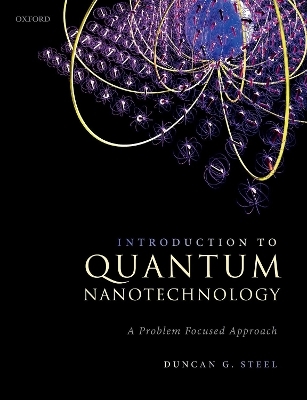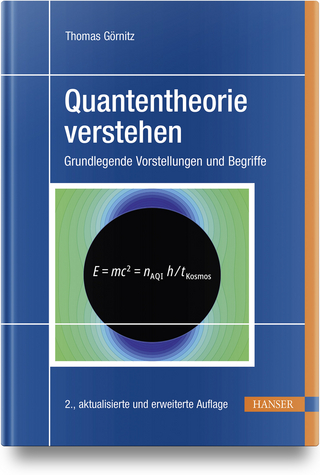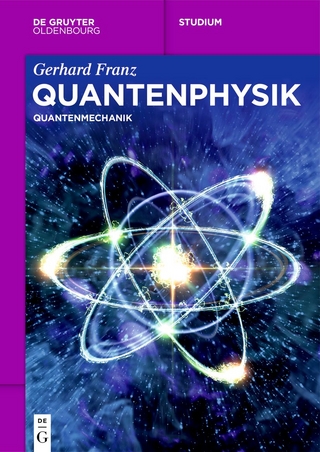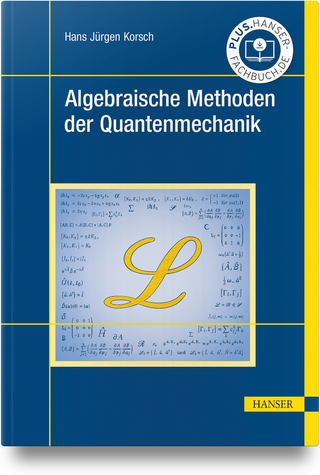
Introduction to Quantum Nanotechnology
Oxford University Press (Verlag)
978-0-19-289507-3 (ISBN)
Quantum is rapidly emerging as a game-changer in technology. The end of Moore's Law for exponential growth is rapidly approaching and engineers and physicist alike are looking at moving past the classical limitations of modern technology and are exploring the new opportunities that quantum behaviour creates in sensing, metrology, communications and information processing. This book serves as introduction to quantum theory with emphasis on dynamical behaviour and applications of quantum mechanics, with minimal discussion of formalism. The goal is to help students begin to learn the tools for a quantum toolbox they will need to work in this area. It is aimed at upper level undergraduates and first year graduate students and assumes the reader has not had any training in quantum mechanics beyond what might be encountered in two semesters of introductory physics. The language of quantum is mathematics and builds on what is covered in typically the first two years. The first six chapters introduce Schrödinger's equation and develop the quantized description of common systems that exist in real space like a vibrator, nano-particles, atoms, crystals, etc. Beginning in Ch. 7 and for the remaining nine chapters, the focus is primarily on dynamical behaviour and how to think about real quantum systems. Spin, the quantized electromagnetic field, dissipation, loss and spontaneous emission, are discussed as well as quantum optics and the operator equations for common two-state systems such as the quantum flip flop and the density matrix equations. The book is structured so that a two semester course sequence is possible or a single semester course with options discussed in the preface to set different learning objectives. Even a one semester course based on this text covers much more material than a typical upper quantum course for undergraduates in physics, but at the expense of more detailed discussions about solutions to various differential equations such as for angular momentum and the hydrogen atom or band theory for semiconductors.
Duncan G. Steel, The Robert J. Hiller Professor, Professor of Electrical Engineering and Computer Science, Professor of Physics, The University of Michigan - Ann Arbor. PhD in 1976 in Electrical and Nuclear Science, University of Michigan. Guggenheim Fellow (1999), APS Isakson Prize (2010), Elected Fellow of APS, OSA, and IEEE. 10 years at Hughes Research Laboratories (senior staff physicist), faculty at the University of Michigan (1985-), Area Chair for Optics and Director of the Optical Sciences Laboratory 1988-2007, Director of Biophysics 2007-2009.
Chapter 1. Introduction to Applied Quantum Mechanics - Why quantum behavior is impacting technology.
Chapter 2. Nano Mechanical Oscillator and Basic Dynamics: Part I
2.1: Introduction
2.2: The Classical Approach: Finding
2.3: The Quantum Approach: Finding
2.4: Is it Classical or Quantum?
2.5: What is Knowable in a Quantum System?
2.6: Coherent Superposition States and Coherent Dynamics
2.7: The Particle and the Wave
2.8: Summary
Chapter 3. Free Particle, Wave Packet and Dynamics, Quantum Dots and Defects/Traps Scattering and Transport.
3.1: Introduction
3.2: The Free Particle
3.3: Localized State in Free Space: The Wave Packet
3.4: Nano-Heterostructures: Quantum Dots and Deep Traps
3.5: A Particle Trapped in a Shallow Defect
3.6: A Particle Trapped in a Point Defect Represented by a Dirac Delta-Function Potential
3.7: Physical Interpretation of the Dirac -function potential
3.8: Summary
Chapter 4. Periodic Hamiltonians and the Emergence of Band Structure: The Bloch Theorem and the Dirac Kronig-Penney model.
4.1: Introduction
4.2: The Translation Operator
4.3: Crystals and Periodic Potentials: The Bloch Theorem and the Dirac Kronig-Penney Model
4.4: Summary
Chapter 5. Scattering, Quantum Current, and Resonant Tunneling
5.1: Introduction
5.2: Scattering
5.3: Tunneling Through a Repulsive Point Defect Represented by a Dirac -Function Potential
5.4: Resonant Tunneling
5.5: Summary
Chapter 6. Bound States in 3-dimensions: The Atom.
6.1: Introduction
6.2: The Hydrogenic Atom
6.3: Summary
Chapter 7. The New Design Rules for Quantum: The Postulates.
7.1: Introduction
7.2: The Postulates of Quantum Mechanics
7.3: The Heisenberg Uncertainty Principle: The Minimum Uncertainty State
7.4: Interpreting the Expansion Coefficients: Relating Functional Form to Dirac Form
7.5: Summary
Chapter 8. Heisenberg Matrix Approach: Nano-Mechanical Oscillator and the Quantum LC Circuit.
8.1: Introduction
8.2: Heisenberg or Matrix Approach to Solving the Time Independent Schrödinger Equation
8.3: Matrix Representation of Operators and Eigenvectors in Quantum Mechanics
8.4: The Quantum LC Circuit
8.5: Summary
Chapter 9. Quantum Dynamics: Rabi Oscillations and Quantum Flip-Flops.
9.1: Introduction
9.2: Time Evolution Operator
9.3: The Heisenberg Picture of Dynamics
9.4: The Interaction Picture
9.5: A Quantum Flip-Flop: Coherent Control of a Two-Level System and Rabi Oscillations
9.6: Summary
Chapter 10. The Quantum Gyroscope: The Emergence of Spin.
10.1: Introduction
10.2: Angular Momentum with the Heisenberg Approach
10.3: Intrinsic Angular Momentum: Spin
10.4: The Bloch Sphere and Spin
10.5: Addition of Angular Momentum
10.6: Angular Momentum and the Rotation Operator
10.7: Summary
Chapter 11. Time Independent and Time Dependent Perturbation Theory.
11.1: Introduction
11.2: Time Independent Perturbation Theory.
11.3: Time Dependent Perturbation Theory: Fermi's Golden Rule
11.4: Summary
Chapter 12. Bosons and Fermions: Indistinguishable particles with intrinsic spin.
12.1: Introduction
12.2: Eigenfunctions and Eigenvalues of the Exchange Operator
12.3: The Exchange Symmetry Postulate: Bosons and Fermions
12.4: The Heitler-London Model
12.5: Summary
Chapter 13. Quantum Measurement and Entanglement: Wave-Function Collapse
13.1: Introduction
13.2: Quantum Measurement
13.3: Quantum Entanglement and the Impact of Measurement
13.4: Quantum Teleportation
13.5: Summary
Chapter 14. Loss and Decoherence: The RLC Circuit
14.1: Introduction
14.2: Coupling to a Continuum of States: The Weisskopf-Wigner Approximation
14.3: Decay in the Nano-Vibrator Problem
14.4: The RLC Circuit
14.5: Summary
Chapter 15. The Quantum Radiation Field: Spontaneous Emission and Entangled Photons
15.1: Introduction
15.2: Finding the Hamiltonian for the Transverse Electromagnetic Field
15.3: Quantizing the Field
15.4: Spontaneous Emission
15.5: The Effects of the Quantum Vacuum on Linear Absorption and Dispersion
15.6: Rabi Oscillations in the Vacuum: The Jaynes Cummings Hamiltonian
15.7: Summary
Chapter 16. Atomic Operators
16.1: Introduction
16.2: Defining the Atomic Operators
16.3: The Physical Meaning of the Atomic Operators
16.4: The Atomic Operators in the Heisenberg Picture
16.5: The Exact Solution for the Atomic Operators for a Monochromatic Field
16.6: The Operator Equations of Motion Including Spontaneous Emission
Chapter 17. Quantum Electromagneticst
17.1: Introduction
17.2: The Number State Representation
17.3: The Coherent State
17.4: Quantum Beam Splitter: Quantum Interference
17.5: Resonant Rayleigh Scattering: A Single Quantum Emitter
17.6: Creating a Quantum Entangled State Between a Photon and an Electron
17.7: Engineering the Quantum Vacuum
17.8: Summary
Chapter 18. The Density Matrix: Bloch Equations
18.1: Introduction
18.2: The Density Matrix Operator
18.3: The Density Matrix Equations Including Relaxation
18.4: Solving the Reduced Density Matrix for a Two-Level System in the Presence of Resonant Classical Electromagnetic Field
18.5: Rate Equation Approximation
18.6: The Three-Level System: Emerging Importance in Quantum Technology
18.7: Summary
Appendices
A: Essential Mathematics Review
B: Power Series for important Functions
C: Properties and Representations for the Dirac Delta Function
D: Vector Calculus and Vector IdentifiesThe Electromagnetic Hamiltonian and the Göpert-Mayer Transformation
E: The Electromagnetic Hamiltonian and the Göpert-Mayer Transformation
F: Maxwell's Equations in Media, the Wave Equation and Coupling to a two-level system
G: Wigner-Eckart Theorem for evaluating matrix elements.
| Erscheinungsdatum | 07.07.2021 |
|---|---|
| Zusatzinfo | 52 line drawings and halftones |
| Verlagsort | Oxford |
| Sprache | englisch |
| Maße | 196 x 254 mm |
| Gewicht | 1002 g |
| Themenwelt | Naturwissenschaften ► Physik / Astronomie ► Quantenphysik |
| Naturwissenschaften ► Physik / Astronomie ► Thermodynamik | |
| Technik | |
| ISBN-10 | 0-19-289507-9 / 0192895079 |
| ISBN-13 | 978-0-19-289507-3 / 9780192895073 |
| Zustand | Neuware |
| Haben Sie eine Frage zum Produkt? |
aus dem Bereich


